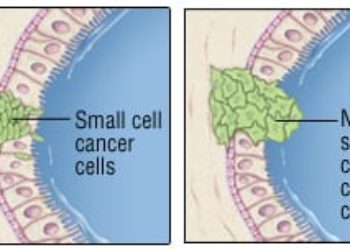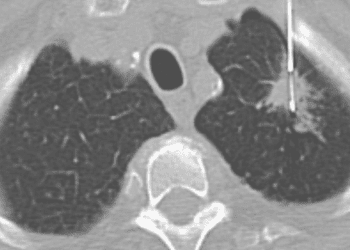“Lung-RADS” lung cancer screening may reduce false positives vs NLST screening
1. When applied to the original NLST cohort, Lung-RADS lung cancer screening criteria had a lower false positive rate, a higher positive predictive value and a lower sensitivity, compared to the NLST criteria.
Evidence Rating Level: 2 (Good)
Study Rundown: The National Lung Screening Trial (NLST) criteria for lung cancer screening resulted in a 20% reduction in lung cancer-specific death, but also had a high rate of false positives. To reduce these, the American College of Radiology (ACR) developed the Lung Imaging Reporting and Data System (Lung-RADS), and this retrospective analysis sought to investigate how this screening criteria for lung nodules could impact the performance characteristics (sensitivity, false positive rate, positive predictive value) when applied to the original NLST cohort of high-risk current and former smokers. Notably, the positivity criterion for Lung-RADS was 6mm diameter for a solid nodule, compared to 4mm with NLST. Compared to NLST, the Lung-RADS had a significantly lower sensitivity, lower false-positive rate, and higher positive predictive value in both baseline and after-baseline screenings. Lung-RADS would have avoided half of the baseline screening false positives, three-fourths of the after-baseline false-positives and subsequently sending a large number of baseline false positive cases for invasive diagnostic testing. However, Lung-RADS also would have missed 86 cancers. These true positives had similar stages of cancers as those correctly identified by Lung-RADS. Importantly, there was no significant difference in lung cancer-specific survival between cancers that were missed and not missed by Lung-RADS. The major limitations to this study were its retrospective nature and the possibility of confirmation bias amongst radiologists.
Click to read the study, published today in the Annals of Internal Medicine
Relevant Reading: Performance of ACR Lung-RADS in a Clinical CT Lung Screening Program
In-Depth [retrospective cohort]: In this study, the ACR Lung-RADS lung nodule screening criteria were applied retrospectively to the NLST cohort of 26,455 high-risk current and former smokers between 55 to 74 years old with >30 pack-years history. For baseline screenings, Lung-RADS showed an 8.6% reduction in sensitivity (p <0.001; NLST 93.5% to Lung-RADS 84.9%) and reduced the false-positive rate by 13.8% (p<0.001; NLST 26.6% to Lung-RADS 12.8%). The positive predictive value at baseline was significantly higher with Lung-RADS compared to NLST (p <0.001). After-baseline screening, sensitivity was decreased by 15.2% using Lung-RADS (p <0.001; NLST 93.8% to Lung-RADS 78.6%). The after-baseline false positive rate was 16.5% lower (p <0.001) using Lung-RADS (5.3%; NLST 21.8%), and the corresponding positive predictive value was significantly higher with Lung-RADS (p <0.001). NPV was very high (≥99.8%) for both Lung-RADS and NLST at all screenings, though it was still significantly higher for NLST than Lung-RADS.
Image: PD
©2015 2 Minute Medicine, Inc. All rights reserved. No works may be reproduced without expressed written consent from 2 Minute Medicine, Inc. Inquire about licensing here. No article should be construed as medical advice and is not intended as such by the authors or by 2 Minute Medicine, Inc.





